At the beginning of the 2010’s, I wrote a post about the rise of the marketing technologist. It was the early days of a new, hybrid professional emerging: rare “unicorns” who combined IT skills with marketing domain expertise and a genuine passion for harnessing the blossoming marketing technology landscape.
Fast-forward to the start of 2020’s. Marketing technologists aren’t rare anymore. They’ve been fruitful and multiplied and are now an integral part of modern marketing organizations.
But while all marketing technologists share a common comfort with mastering martech in their work, they’re far from homogenous. They apply martech in different ways. They specialize in different martech tools. They exhibit different skills and talents. And they certainly have a wide range of titles and responsibilities.
It’s a large and diverse field.
So when Henry Powderly, VP of content at Third Door Media (the producers of the MarTech conference and publishers of MarTech Today), asked me last week what I thought the current “archetypes” of marketing technologists were, I found the question irresistibly intriguing.
The chart above is the product of that brainstorm with him.
It also benefited from terrific input by the martech community. I shared a rough, back-of-the-napkin version of the framework on Twitter, which elicited a ton of great feedback. Iterating in agile fashion, I then circulated a second, more refined version, garnering yet more thoughtful reactions from people — and a lively discussion thread on LinkedIn. Thanks, Team #MarTech!
4 (well, really 5) Archetypes/Roles of Marketing Technologists
The model classifies marketing technologist activities along two axes:
- X Axis: Internal Orientation to External Orientation
- Y Axis: Process Orientation to Technology Orientation
Internal Orientation is about serving stakeholders inside the organization, while External Orientation is about engagements with customers. Process Orientation is about workflows and customer journeys, while Technology Orientation is more about engineering with data and code.
I chose the word “orientation” very carefully, so as to not imply an exclusive focus. Nearly every marketing technologist connects across all of these dimensions to some degree. But different roles lean towards different ends of the spectrum.
The resulting 2×2 gives us four marketing technologist archetypes or roles:
- Brand/Demand Builder — MARKETERS who are fluent with the use of martech in their work, focused on applying it in campaigns and programs to attract, engage, and retain customers. Typical titles: Marketing Manager, Growth Marketer
- Operations Orchestrator — MAESTROS who design and manage the workflows, rules, reports, and tech stacks that run the marketing department. Typical titles: Marketing Operations, CRM/MAP Admin
- Analytics Architect — MODELLERS who dive deeper into the structure (and infrastructure) of data that marketing collects and uses for business/customer intelligence. Typical titles: Marketing Analyst, Data Scientist, Data Engineer
- Marketing Maker — MAKERS who build custom apps and digital experiences with code (and, increasingly, with no-code tools). Typical titles: Web/App Developer, Marketing Engineer. See also: Citizen Technologist (not really a title, but a competency)
(Apologies: I’m afflicted with affection for alliteration.)
Of course, real life is more complex than any model. An individual marketing technologist can have skills and experience across multiple quadrants. Specific jobs within a department may combine these roles or sit in the middle between them. But the characteristics of work within each of these quadrants are different and can benefit from specialization.
Marketing Technologists in the Broader Marketing Organization
How does this map of marketing technologists fit within marketing overall? There are clearly a lot of other roles in marketing. Strategy and leadership sets the direction. And let’s not forget that everything in marketing should revolve around customers.
I picture these marketing technologist roles as a layer within the broader organization:
It reads left to right, because I thought that was easier to visualize, but conceptually it’s really more top-down:
- Marketing Leadership & Strategy
- Marketing Technology & Operations Leadership
- Marketing Technologist Roles
- The Entire Marketing Organization
- Customers
Don’t think of customers as being on the bottom. Think of them as the foundation. They are the bedrock upon which everything in marketing should be built.
This marketing pyramid also reveals a fifth archetype: a MANAGER who oversees the breadth of marketing technology and operations.
Once upon a time, I called this role the chief marketing technologist. In practice, typical titles are VP/director of marketing technology and/or marketing operations.
It’s more of a role of people management, as well as having the responsibility for overarching martech strategy and governance — connecting it with overall marketing strategy, set by the CMO at the next layer up.
I drew the connecting lines between the points of these archetypes — a K5 complete graph for any fellow graph theory geeks out there — to also make the point that just because there are specializations in martech, doesn’t mean they have to be silos. Marketing is a team sport.
Henry connected the dots between this framework and the martech maturity model that I had published last year. As more and more people throughout the marketing department gain martech skills (“absorbed” martech maturity) the middle layers of this pyramid — marketing technologists and the overall marketing organization — converge:
Marketing technologists also interface with other departments beyond marketing: sales and customer success for external-oriented activities; IT, finance, and legal for more internal-oriented ones. Especially in digital businesses, there’s a tight intersection between these roles and the product organization — this is where a lot of “growth”-titled positions tend to live.
“All models are wrong, but some are useful,” declared the statistician George Box. Hopefully this model is directionally useful for understanding different kinds of marketing technologist skills and roles within the modern marketing department.
I’d love your feedback and suggestions for further iterations.
P.S. If you identify with any of these marketing technologist roles or archetypes, you should join us for the MarTech conference in San Jose, April 15-17. It’s your tribe, and we’ll have great sessions by experts from across this entire spectrum of marketing technologist practitioners.
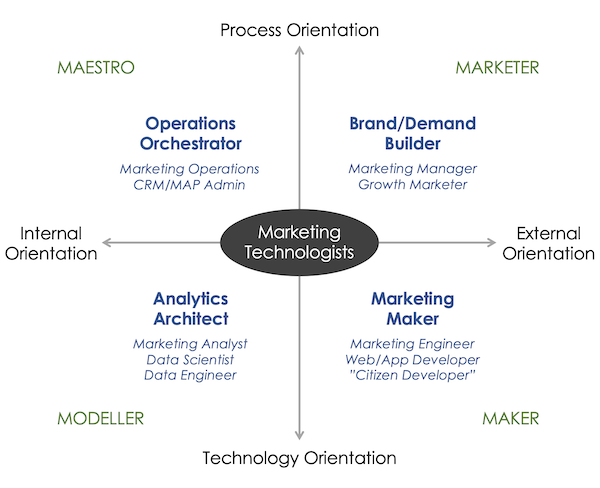
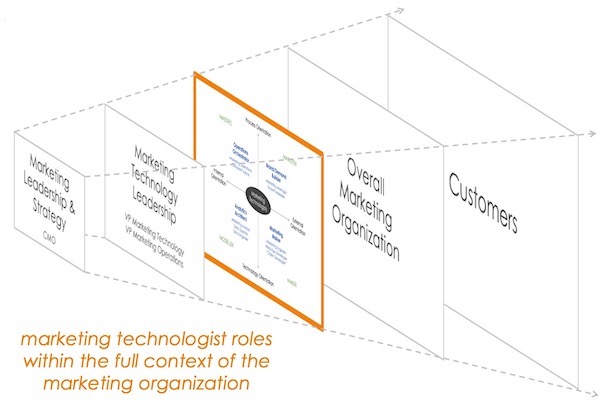
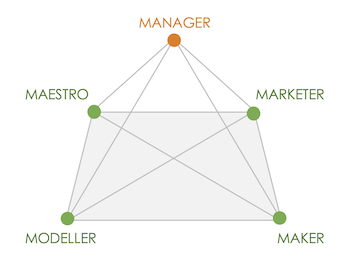
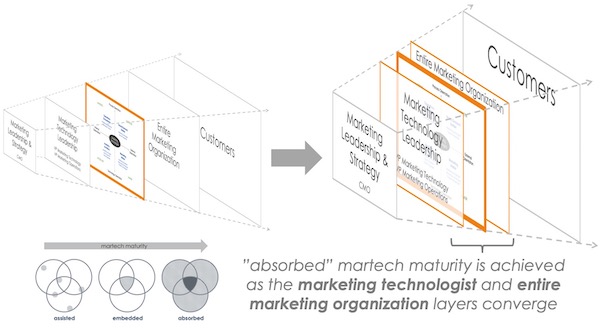
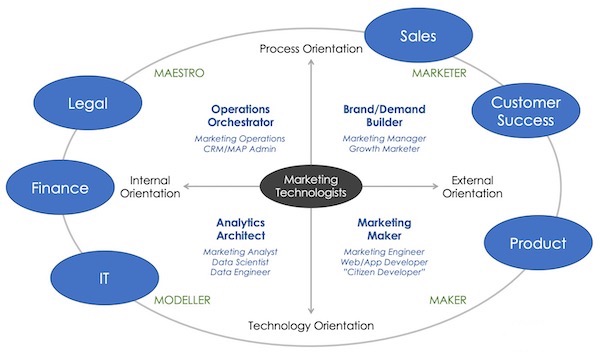



I’m wondering if the bottom of the Y-axis should be “Technical” rather than “Technology.” More of technical disciplines and competencies than an affinity for technology, which is sort of universal across all the quadrants.
Hey Scott – Excellent and helpful breakdown. “Splendid” for sure! It is great to see Sales represented at the priority top-right location!
Scott – Curious to know where you place Product Marketing in all of this. Brand/Demand Builder? Marketing Leadership & Strategy layer? The content creators and strategists can be tech savvy but aren’t exactly MarTech as you define it. Thoughts?
I find myself somehow ending up smack dab in the middle. Which makes me think its time to cut away and pursue an archetype
There’s value in both — having a broad set of skills across the entire spectrum and developing deep expertise in one or two.